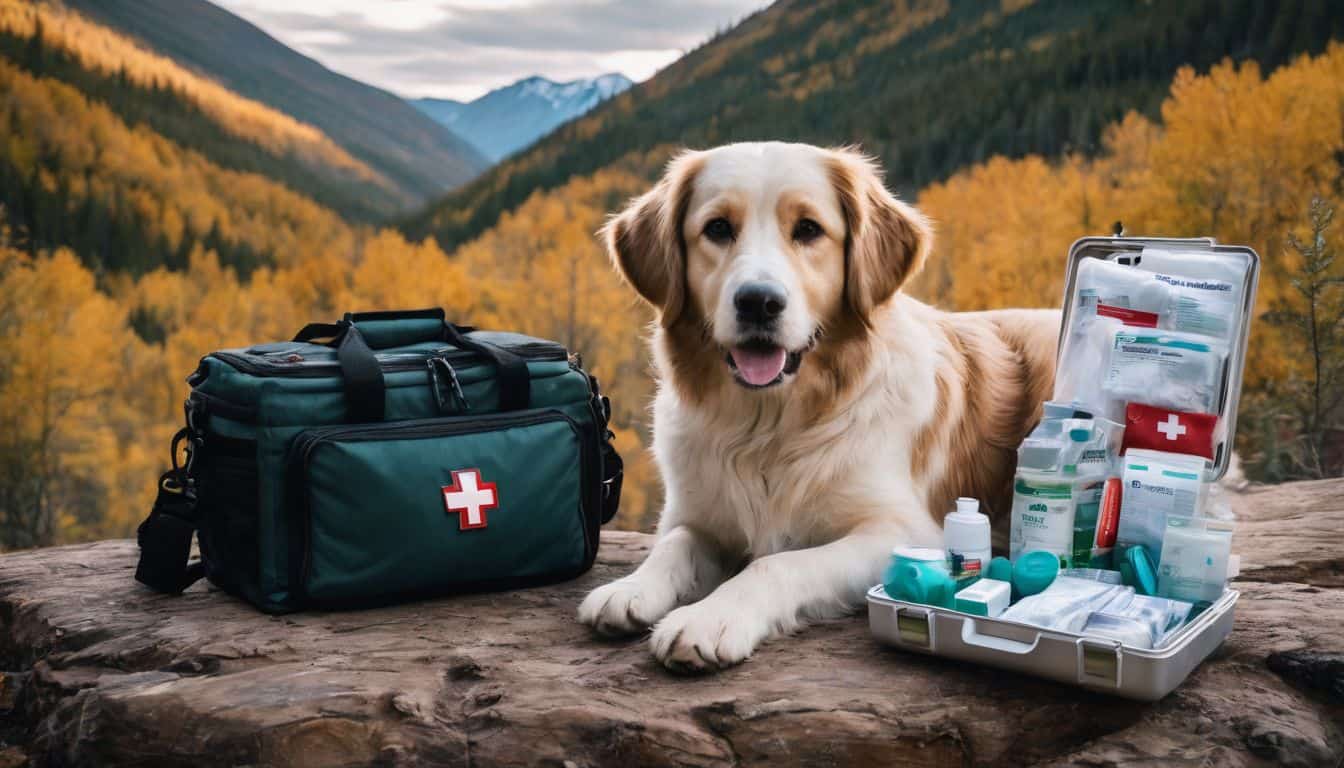When camping with dogs, being prepared for potential emergencies is crucial. A well-stocked first aid kit and knowledge of basic first aid techniques can make a significant difference in ensuring your canine companion’s safety and well-being during outdoor adventures.
This quide will help you assemble and use a dog first aid kit for your camping trips, as well as provide you with essential information on handling common emergencies.
Essential Items for Your Dog’s First Aid Kit
A properly equipped first aid kit is the foundation of emergency preparedness for your dog. Here are the essential items you should include:
- Gauze and non-stick bandages for wound care
- Adhesive tape to secure bandages
- Scissors (blunt-tipped) for cutting bandages and tape
- Tweezers for removing splinters or ticks
- Hydrogen peroxide (3%) for cleaning wounds
- Antibiotic ointment to prevent infection
- Saline solution for flushing wounds or eyes
- Benadryl (diphenhydramine) for allergic reactions
- Tick remover tool for safe tick removal
- Paw balm to protect and soothe paw pads
- Vet wrap for secure, flexible bandaging
- Muzzle or cloth to make an emergency muzzle
- Emergency blanket for warmth in cold conditions
- Collapsible water bowl for hydration
- Copy of vaccination records for veterinary emergencies
Having these items readily available can help you address a variety of common camping emergencies quickly and effectively. It’s also a good idea to familiarize yourself with each item and its use before your camping trip.
Addressing Common Camping Emergencies
Cuts and Scrapes
Minor injuries like cuts and scrapes are common during outdoor activities. To treat these:
- Clean the wound thoroughly with saline solution to remove any dirt or debris
- Apply antibiotic ointment to prevent infection
- Bandage the wound if necessary to keep it clean and protected
- Monitor the wound for signs of infection, such as increased redness, swelling, or discharge
Insect Bites or Stings
If your dog experiences an insect bite or sting:
- Remove the stinger if visible using tweezers, being careful not to squeeze the venom sac
- Apply a cold compress to reduce swelling and discomfort
- Administer Benadryl if swelling occurs (consult your vet for proper dosage before your trip)
- Watch for signs of a severe allergic reaction, such as difficulty breathing or excessive swelling
Tick Removal
Ticks are a common concern when camping. To safely remove a tick:
- Use a tick remover tool for the best results
- Grasp the tick close to the skin and pull straight out with steady pressure
- Clean the area with antiseptic after removal
- Save the tick in a sealed container for identification if your dog develops symptoms later
Paw Injuries
To keep your dog safe while camping, pay special attention to their paws:
- Clean any injured paw with saline solution
- Apply paw balm for minor cuts or dryness
- Bandage if necessary, using vet wrap for a secure and comfortable fit
- Consider using dog booties to protect paws from rough terrain or extreme temperatures
Heat Exhaustion
In case of heat exhaustion:
- Move your dog to a cool, shaded area immediately
- Offer fresh water to drink, but don’t force it
- Use a damp towel to cool them down gradually, focusing on the neck, armpits, and groin areas
- Monitor their temperature and breathing, seeking veterinary care if symptoms persist
Allergic Reactions
If your dog shows signs of an allergic reaction:
- Administer Benadryl (consult your vet for the appropriate dosage before your trip)
- Apply a cold compress to reduce swelling
- Seek veterinary care if symptoms are severe or persistent, especially if there’s difficulty breathing
Preventive Measures
Prevention is always better than cure. Here are some preventive measures to keep in mind:
- Keep your dog on a leash to prevent accidents and encounters with wildlife
- Check for ticks daily, especially after walks in wooded areas
- Ensure proper hydration by offering water frequently and bringing enough for your entire trip
- Protect paws from hot surfaces and rough terrain with booties if necessary
- Be aware of local wildlife and plants that may be harmful to your dog
- Maintain your dog’s regular flea and tick prevention regimen
- Consider a lightweight, reflective vest for your dog to increase visibility
When to Seek Professional Help
While a first aid kit can help in many situations, some emergencies require immediate veterinary attention. These include:
- Severe bleeding that doesn’t stop with applied pressure
- Difficulty breathing or persistent coughing
- Suspected broken bones or severe lameness
- Ingestion of toxic substances
- Severe allergic reactions (facial swelling, difficulty breathing)
- Persistent vomiting or diarrhea
- Seizures or loss of consciousness
- Heatstroke symptoms (excessive panting, drooling, lethargy, or collapse)
Before your camping trip, locate the nearest emergency veterinary clinic to your campsite and save their contact information. This preparation can save precious time in case of a serious emergency. It’s also a good idea to discuss your camping plans with your veterinarian, who can provide specific advice based on your dog’s health and the area you’ll be visiting.
This guide is not a substitute for professional veterinary care. Always consult with your veterinarian before administering any medications or treatments, and seek professional help for serious injuries or illnesses.

Training and Preparation
To enhance your ability to handle emergencies, consider taking a pet first aid course before your camping trip. These courses can provide hands-on training and more in-depth knowledge of emergency procedures.
Additionally, practice using the items in your first aid kit at home. Familiarize your dog with being handled in ways similar to first aid procedures, such as checking paws or applying bandages. This can help reduce stress for both you and your dog in an actual emergency situation.
By being prepared with a well-stocked first aid kit and knowledge of basic first aid techniques, you can ensure a safer and more enjoyable camping experience for both you and your canine companion. For more comprehensive information on managing your dog’s health while camping, be sure to check out our detailed guide.
Conclusion
Camping with your dog can be an incredibly rewarding experience, creating lasting memories and strengthening your bond. By prioritizing your dog’s safety and being prepared for potential emergencies, you can focus on enjoying the great outdoors together with peace of mind.
The key to a successful camping trip with your dog lies in thorough preparation, vigilant care, and a readiness to act quickly when needed. With these essential first aid skills and supplies at your disposal, you’ll be well-equipped to handle most situations that may arise during your outdoor adventures.

Leave a Reply